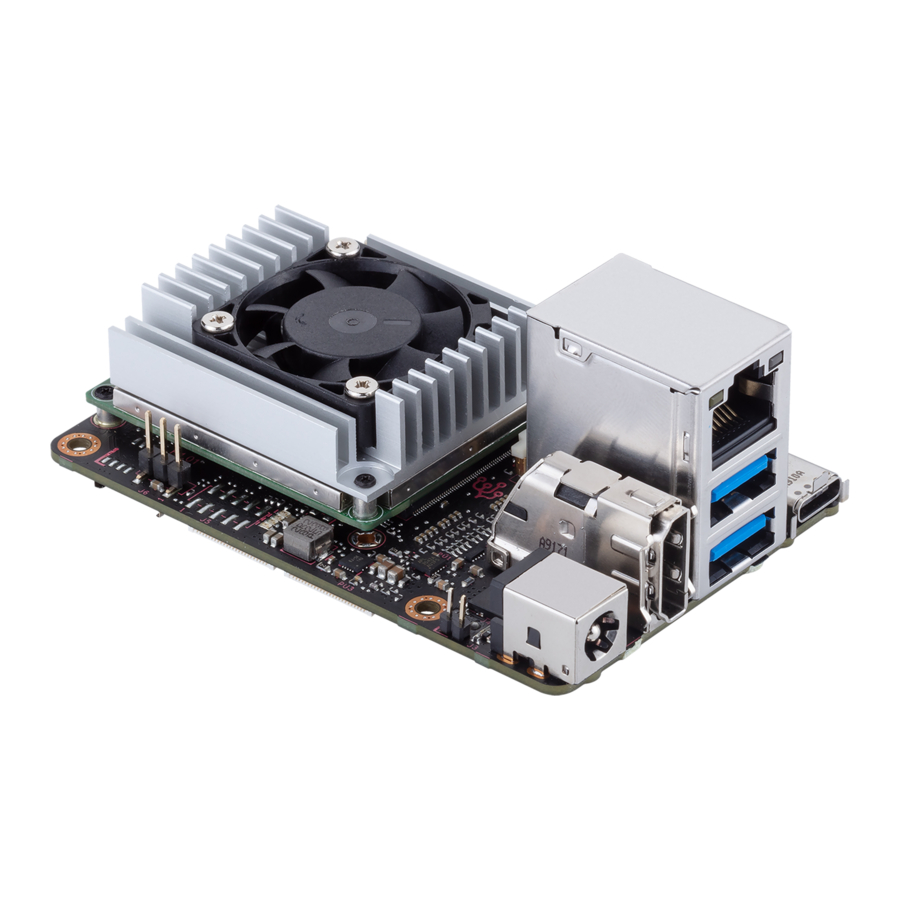
Advertisement
Quick Links
Getting Started
Requirement
• 1 x USB Type-C® cable with data transfer function (to connect your PC to the board's data port)
• 1 x 12~19V power supply*
• 1 x Monitor with HDMI cable
• 1 x Keyboard and Mouse set
* The power supply is purchased separately.
* The factory settings only includes a U-Boot bootloader and does not include a system
Before you begin the flashing procedure, please ensure of the following:
• The board is completely powered off, and the power cord and cables connecting the board to
your computer are all disconnected.
• The boot mode switches are set to eMMC mode, please refer to the table and illustration below
for the eMMC mode setting.
Image list
https://www.asus.com/AIoT-Industrial-Solutions/Tinker-Edge-T/HelpDesk_Download/
Flashing the Tinker Edge T
Initiating Fastboot mode:
I. Connect the USB Type-C® cable to the USB Type-C® ports on the Tinker Edge T and your host
computer.
II. Power on the board, you should automatically be booted into Fastboot mode.
Please note that you will only be booted into Fastboot mode when booting up the Tinker
Edge T for the first time.
Please refer to the readme file in the unzipped folder for details on other items such as re-
flash or recovery.
Executing the flash script:
I. Download the OS image from the Tinker Edge T website, then unzip the image file.
II. Run the flash script or command file to start the flash process. The flash process should
take a few minutes. Once the flash is completed, the Tinker Edge T will reboot and you
should be booted to the terminal prompt.
Advertisement

Summary of Contents for Asus Tinker Edge T
- Page 1 Flashing the Tinker Edge T Initiating Fastboot mode: I. Connect the USB Type-C® cable to the USB Type-C® ports on the Tinker Edge T and your host computer. II. Power on the board, you should automatically be booted into Fastboot mode.
-
Page 2: Customize Settings
Please refer to the readme file in the unzipped folder for troubleshooting steps. Customize Settings Change Keyboard Layout The keyboard layout is set to English (US) as default setting. Refer to the process below to change the language. sudo dpkg-reconfigure keyboard-configuration sudo reboot Change Time Zone/Date/Time... - Page 3 By default, the output is locked at a resolution of 1920 x 1080. Change this setting by editing file at /etc/xdg/weston/weston.ini. In the [output] section, edit the line mode=1920x1080 to be a resolution of your choice. Check Audio’s Output Interface ...
- Page 4 Use caution when handling the GPIO pins to avoid electrostatic discharge or contact with conductive materials (metals). Failure to properly handle the Tinker Edge T can result in a short circuit, electric shock, serious injury, death, fire, or damage to your board and other property.
- Page 5 Using the Periphery library To access the header pins on the Tinker Edge T, you can use standard Linux sysfs interfaces. But if you'd like a Python API, we recommend you use the python-periphery library, which is built atop the sysfs interfaces.
- Page 6 For usage examples, see the https://python-periphery.readthedocs.io/en/latest/pwm.html. The following code shows how to instantiate each of the I2C ports with Periphery: i2c2 = I2C("/dev/i2c-1") i2c3 = I2C("/dev/i2c-2") For usage examples, see the https://python-periphery.readthedocs.io/en/latest/i2c.html. The following code shows how to instantiate each of the SPI ports with Periphery: # SPI1, SS0, Mode 0, 10MHz spi1_0 = SPI("/dev/spidev32766.0", 0, 10000000) # SPI1, SS1, Mode 0, 10MHz...
- Page 7 Sample Code blink.py from periphery import GPIO import time LED_Pin = 73 #Physical Pin-16 is GPIO 73 # Open GPIO /sys/class/gpio/gpio73 with output direction LED_GPIO = GPIO(73, "out") while True: try: #Blink the LED LED_GPIO.write(True) # Send HIGH to switch on LED print("LED ON!") time.sleep(0.5)
- Page 8 How to check current hardware information Current CPU frequency To read current real-time CPU frequency: sudo cat /sys/devices/system/cpu/cpufreq/policy0/cpuinfo_cur_freq Current GPU frequency To read current GPU frequency sudo cat /sys/kernel/debug/gc/clk | grep sh | awk '{print $4}' Current CPU & GPU Temperature To monitor real-time SoC temperature watch -n 1 sudo cat /sys/class/thermal/thermal_zone0/temp Advanced Script...
- Page 9 $ sudo chmod +x hwinfo_moniter.sh $ ./hwinfo_moniter.sh SoC => 55.00°C also can watch it every seconds by: $ watch -t -p -n 1 ./hwinfo_moniter.sh...
- Page 10 Requirements Tinker Edge T Image version >= TINKER_EDGE_T-MENDEL-0.0.14-20190904 2 x Coral or AIY’s MIPI Camera Set up on Tinker Edge T and MIPI Camera Insert the two MIPI camera to the CSI ports (Red part) of Tinker Edge T: Back:...
- Page 11 Power on Tinker Edge T and open the terminal by mouse (Red part): Enter the name of demo app in the terminal (edgetpu_object_detect or edgetpu_face_detect) (Red part): edgetpu_object_detect : Object Detection by MobileNet-SSD v2 edgetpu_face_detect: Face Detection by MobileNet-SSD v2...
- Page 12 7. Minimized the terminal by clicking the red part and move the camera windows by hold the windows key + mouse left key: 8. You should see results like this: Congrats! You've just performed an inference on Tinker Edge T.




